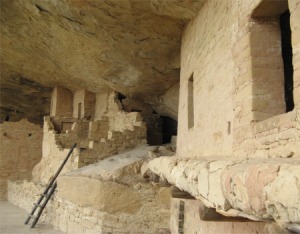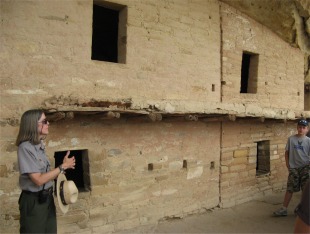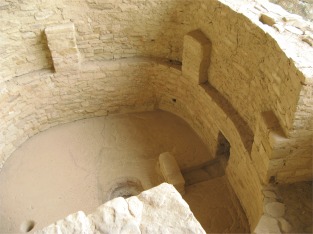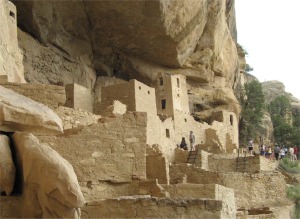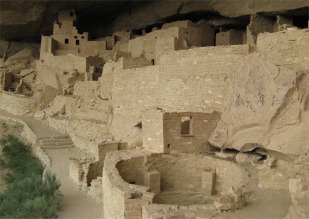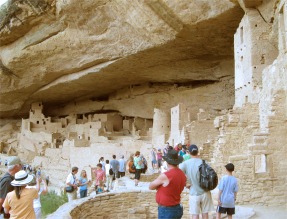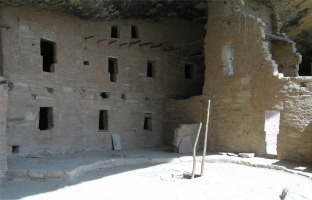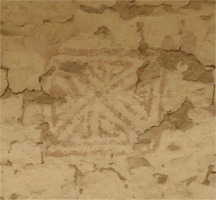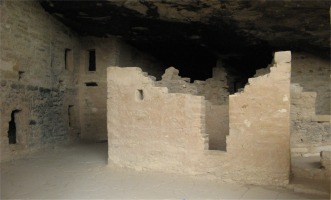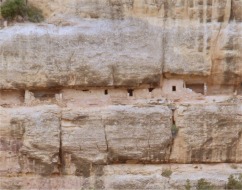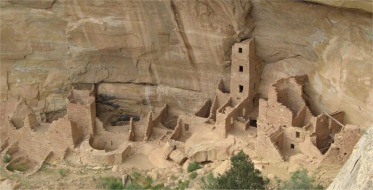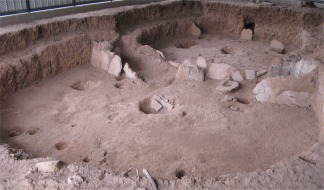I carried on my journey through a high plateau, high enough for fields of grass as far as the eye could see, with just the occasional group of mountains making their presence felt on the horizon. I was coming across ploughed fields every so often, the soil blood red, but I imagined quite fertile. The sun had been bright when I left Moab, but now I noticed clouds in the sky. The roads were long and straight, and I listened to Hendrix whilst keeping an eye out for traffic cops. It was good to be moving on again.
After a 3 hour journey, I reached the Mesa Verde National Park. The sky was now overcast, so the temperature wasn't fierce, but it was slightly humid. "Mesa Verde" is Spanish for green table. The table was indeed green, but there was a vast area of dead trees due to a forest fire. I learned later that the park had suffered six forest fires in the last twelve years. Once past the ranger's entrance post, it was a slow 16 miles to where the actual sites were. I called in at the visitors centre and bought tickets for the three guided tours, other sites in the park were self guided. However, there was a long drive between two of them and the other, forcing me to take in two tours today and another tour tomorrow.
Mesa Verde National Park preserves a spectacular reminder of the 1,000 year culture of the Ancestral Puebloans. Archeologists have called this people Anasazi, from the Navaho word that means "ancient". They are now called Ancestral Puebloans, reflecting their modern descendants.
The first Ancestral Puebloans settled in Mesa Verde about AD 550. They are known as Basketmakers because of their impressive skill at that craft. Formally a nomadic people, they were now beginning to lead a more settled way of life. Farming replaced hunting-and-gathering as their main source of livelihood. They lived in pithouses clustered in small villages, which they usually built on the mesa tops, but occasionally in the cliff recesses. They soon learned how to make pottery and they acquired the bow and arrow, a more efficient weapon for hunting than the atlati (spear thrower).
The pithouse represents the beginning of a settled way of life based on agriculture. Its basic features were a living room, squarish in shape and sunk down a few feet into the ground, four main timbers at the corners to support the roof, a fire pit with an air deflector, an antechamber, which might contain storage bins or pits, and a sipapu. Pithouses evolved into kivas of later times. In Mesa Verde, the people lived in this type of dwelling from about 550 to 750.
These were fairly prosperous times for the Basketmakers, and their population multiplied. About 750 they began building houses above ground, with upright walls made out of poles and mud. They built these houses one against another in long, curving rows, often with a pithouse or two in front. The pithouses were probably the forerunners of the kivas of later time. From then on, these people were known as Pueblos, a Spanish word for village dwellers.
By 1000, the people of Mesa Verde had advanced from pole-and-adobe construction to skillful stone masonry. Their walls of thick, double-coursed stone often rose two or three stories high and were joined together into units of 50 rooms or more. Pottery also changed, as black drawings on a white background replaced simple designs on dull gray. Farming provided more of the diet than before and much mesa top land was cleared for that purpose.
The years from 1100 to 1300 were Mesa Verde's Classic Period. The population may have reached several thousand. It was mostly concentrated in compact villages of many rooms, often with the kivas built inside the enclosing walls rather than out in the open. Round towers began to appear, and there was a rising level of craftsmanship in masonry work, pottery, weaving, jewelry, and even tool making. The stone walls of the large pueblos are regarded as the finest ever built in Mesa Verde; they are made of carefully shaped stones laid up in straight courses. The mortar between blocks was a mix of mud and water. Rooms averaged about 6 foot by 8 foot, space enough for two or three persons. Isolated rooms in the rear and on the upper levels were generally used for storing crops.
Much of the daily routine took place in the open courtyards in front of the rooms. Pottery was fashioned there, as well as various tools - knives, axes, awls, scrapers - made from stone and bone. Baskets show evidence of decline in quality but this may be due to the wide spread use of pottery and consequence less attention to the craft. Fires built in the summer were mainly for cooking. In winter, when the alcove rooms were damp and uncomfortable, fires probably burned throughout the village. Smoke-blackened walls and ceilings are reminders of the biting cold these people lived with for several months each year.
Clothing closely followed the seasons. In summer the adults probably wore simple loincloths and sandals. In the winter, they dressed in hides and skins and wrapped themselves against the cold in blankets made of turkey feathers and robes of rabbit fur.
The Ancestral Puebloans spent much of their time getting food, even in the best of years. Farming was the main business of these people, but they supplemented their crops of corn, beans and squash by gathering wild plants and hunting deer, rabbits, squirrels, and other game. Their only domestic animals were dogs and turkeys.
Fortunately for us, the Ancestral Puebloans tossed their trash close by. Scraps of food, broken pottery and tools, anything unwanted, went down the slopes in front of their homes. Much of what we know about their daily life here comes from these garbage heaps.
The Ancestral Puebloans used all available materials, without any metal of any kind. They skillfully fashioned stone, bone and wood into a variety of tools for grinding, cutting, chopping, weaving, scraping and polishing. They used the digging stick for farming, the stone axe for clearing the land, the bow and arrow for hunting and sharp edged stones for cutting. They ground corn with the metate and mano and made wooden spindle whorls for weaving. From bones they fashioned awls for sewing and scraping. They usually made their stone tools from stream cobble rather than soft sandstone of the cliffs.
The finest baskets produced by the Mesa Verde people were made before they learned how to make pottery. Using the spiral twilled technique, they wove handsomely decorated baskets of many sizes and shapes and used them for carrying water, storing grain, and even cooking. They water proofed their baskets by lining them with pitch and cooked in them by dropping heated stones into the water. The most common coiling material was split willow, but sometimes rabbitbush or skunkbush was used. After the introduction of pottery about AD 550, basketry declined. The few baskets found here from the Classic Period is inferior to those made earlier.
The people of Mesa Verde were accomplished potters. They made vessels of all kinds; pots, bowls, canteens, ladies jars, and mugs. Corrugated ware was used mostly for cooking and storage; the elaborately decorated black-on-white ware may have had ceremonial, as well as everyday uses. Women were probably the potters of the community. Their designs tended to be personal and local, and most likely were passed down from mother to daughter. Design elements changed slowly, a characteristic that helps archeologists and modern descendants track the location and composition of early populations.
Archeology has yielded some information about the ancient people of Mesa Verde, but without written record there is no way to be sure about their social, political, or religious ideas. We must rely for insight on comparisons with the modern Pueblo people of New Mexico and Arizona. In Classic times Mesa Verde, several generations probably lived together as a household. Each family occupied several rooms and built additional ones as it grew. Several related families constituted a clan which was probably matrilineal (descent through the female line) in organization. If the analogy with current Hopi practice is correct, each clan had its own kiva and rights to its own agricultural plots.
Mesa Verde's economy was more complex than it might appear to be at first glance. Even within a small agricultural community, there undoubtedly were persons more skilled than others at weaving or leather-working or making pottery, arrowpoints, jewelry, baskets, sandals, or other specialized articles. Their efficiency gave them a surplus, which they shared or bartered with their neighbors. This exchange went on between communities too. Seashells from the Pacific coast and turquoise, pottery, and cotton from the south were some of the item that found their way to Mesa Verde, passed along from village to village or carried by traders on foot over a far-flung network of trails.
About 1200 there was another major population shift. The people began to move back into the cliff alcoves that had sheltered their ancestors long centuries before. Perhaps it was for defense; perhaps the alcoves offered better protection from the elements; perhaps there were religious or psychological reasons. Whatever the reason or combination of reasons, it gave rise to the cliff dwellers for which Mesa Verde is most famous.
Most of the cliff dwellings were built from the late 1190's to the late 1270's. They range in size from one-room houses to villages of more than 200 rooms - Cliff Palace. Architecturally, there is no standard ground plan. The builders fit their structures to the available space. Most walls were single courses of stone, perhaps because the alcove roofs limited heights and also protected them from erosion by the weather. The masonry work varied in quality; rough construction can be found alongside walls with well-shaped stones. Many rooms were plastered on the inside and decorated with painted designs.
Kiva is a Hopi word for ceremonial room. The kiva at Mesa Verde were underground chambers that may be compared to churches of later times. Based upon modern Pueblo practices, Ancestral Puebloans may have used these rooms to conduct healing rites or to pray for rain, luck in hunting, or good crops. Kivas also serve as gathering places, and sometimes as a place to weave. A roof of beams and mud covered each kiva, supported by pilasters. Access was by ladder through a hole in the center of the roof. The small hole in the floor is a sipapu, the symbolic entrance to the underworld.
The Ancestral Puebloans lived in the cliff dwellings for less than 100 years. By about 1300 Mesa Verde was deserted. There are several theories about the reason for their migration. We know that the last quarter of the century was a time of drought and crop failures, but these people had survived earlier droughts. Maybe after hundreds of years of intense use, the land and its resources - the soil, forests, and animals - were depleted. Perhaps there were social and political problems, and the people looked for new opportunities elsewhere. One idea put forward by one of my guides was gleaned from a modern day Puebloan who was visiting the site. She looked at the buildings which comprised two shapes: squares and circles. She said the square represented the male domain, and the circle the female, and by having both there was harmony. However, after 23 years of drought preceding the departure of the Puebloans, she thought that they had come to think that they had lost harmony with nature, and needed to move on. I don't suppose we'll ever know the real reasons.
When the people of Mesa Verde left, they traveled south into New Mexico and Arizona, settling among their kin already there. Whatever happened, some of today's Pueblo people, and perhaps other tribes, are descendants of the cliff dwellers of Mesa Verde.
Balcony House
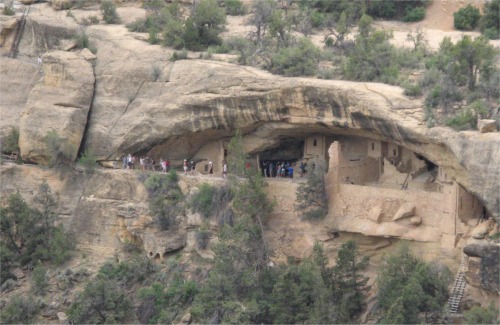 Balcony House |
|
|
|
Cliff Palace
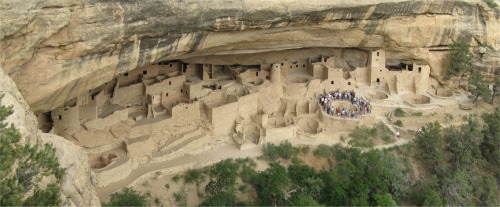 Cliff Palace |
|
|
|
Spruce Tree House
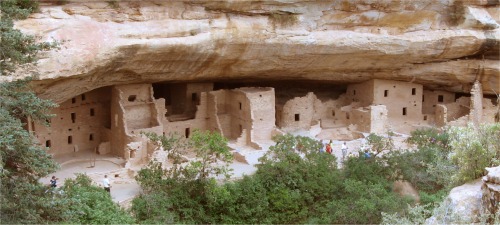 Spruce Tree House |
|
|
|
Down among the dwellings I met a young fellow with a lively babe in his arms. I asked how old the young boy was. "Eight months", was the reply. I got talking about my grandson, and then he got talking about his other three small sons; what a handful. He had been over to England once; London of course, and Blackpool. "What, why Blackpool?", I asked. He had once done a lot of ballroom dancing. He was named Devon; his father had spent a few years there at one time. Makes sense I guess.
|
|
|
A short while later at another viewing point, the same group turned up. Whilst gazing across to cliff dwellings on a ledge on the cliffs opposite, I mentioned to another elderly lady that I had come across similar cliff dwellings in the Dordogne in France. She took it all in, and as I was leaving she summoned me back to explain this to her guide. He listened and said monks still do live in such dwellings. I couldn't argue with that, but they certainly didn't live in the dwellings I saw. I hastily beat a retreat before I ended up on a lecture circuit giving talks on French medieval cliff dwellings.
It was now late, and I headed off to see if I could get a space on a campsite. I checked at the nearest, and for some reason the official thought I was Scottish. While I was still registering, along came another guy who I had been chatting to earlier, and he asked me if I was Scottish. His father had come across from Scotland many years ago. I light-heartedly ticked him off, and all three of us chuckled. Crumbs, I ought to cut down on the whisky.

